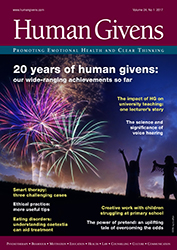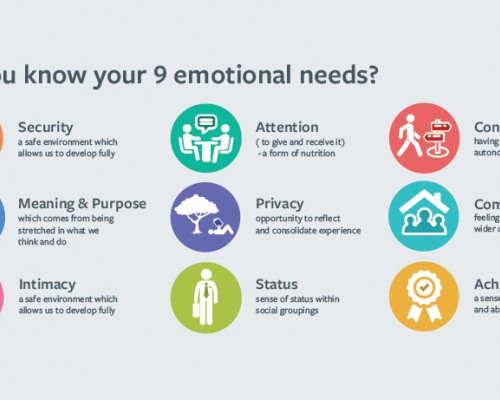Good choices: autism and the human givens
Angela Austin describes how the human givens approach has informed her work to create an emotionally safe environment where children with autism can learn.
In my career teaching children with special needs, I have learned many ways to work with children with autism and have devised many methods of my own. I was thrilled, however, to come across the human givens concept of needs and tools. Its emphasis on identifying and helping to meet needs, and building on innate resources in the process, has given me and my staff a new framework through which to view what we are trying to do. It also reinforces what we are doing by showing why it works. In short, it has created a cohesion to our work and helped us develop a structure to our thinking, rather than merely applying helpful theories and techniques.
Hillingdon Manor School, where I am headteacher, is an independent special school for children aged between three and a half and 19 years of age. Our pupils are variously diagnosed with Asperger's syndrome, high functioning autism or semantic pragmatic disorder. Some children may have a diagnosis of pathological demand avoidance, which means that the focus of their way of being is to resist the demands of everyday life. This can present as panic attacks, which occur as tantrums whenever they are asked to do something.

The school was established in 1999 by parents concerned by the lack of resources for school-age children at the more able end of the autistic spectrum. Local authorities fund the places for the 51 children who attend. From September, we will split into two, with a 'senior school' for children aged 13 plus, and will be able to take 70 children.
While very many of our children are capable of making considerable progress in school, they demonstrate a wide range of challenging behaviours, arising from the "triad of impairments" identified by autism expert Lorna Wing. As a result, many have been excluded from mainstream schools. Children with autism don't understand 'the rules' of engagement unless these are made absolutely explicit, so they almost always find themselves ending up in the wrong.
No one likes to be on the receiving end of criticism or blame but children with autism are especially sensitive to it, and so become highly frustrated and emotional about little upsets. Once they are overwhelmed by their emotions, of course, their rational minds can't function and they cannot learn.
People with autism lack a developed sense of self. They also lack the ability to use language to relate to other people or to solve problems, by themselves or with other people.
For all human beings, language and communication is key for our connecting with the world and, for most of us, the wheels of our daily lives are oiled by shared perceptions and agreements about the meaning of words at a sophisticated level. Children with autism, however, struggle with language at quite a fundamental level. Without a shared understanding of the meaning of words and how they map to names, actions, concepts and emotions, there is no real way to get needs met, understand the world and relate to others.
The concept of choice
I saw this very starkly in the early days of our school. Tina, an 11-year-old girl, was brought into my office, kicking, spitting, biting, swearing and lashing out at anyone who came too close. We calmed her down by using the holding and calming relaxation techniques we teach everyday. When she was calm and able to listen and process information, I wrote on a flipchart what we describe as the three causes of upset:
A: you expect something to happen and it does not
B: you want to do something and someone or something stops you
C: you want to say something and you do not know how to say it.

Then I asked Tina which of these three upset her most. This supposedly under-achieving girl instantly got up and pointed to B. "And what do you choose to do when you want to do something and someone or something stops you?" I asked her. "Bite and spit," she replied. I showed her a smiley face and a sad face and asked, "And how does that make you feel?" She pointed to the sad face. "And how does it make other people feel?" She pointed to the sad face again. "So did that work for you?" "No." "That's really good thinking, Tina. So what could you choose to do that would work?" And Tina looked completely perplexed. She didn't know what she could choose to do. She didn't understand the concept of choice. And, because she lacked the necessary language to map this concept to her neocortex, she couldn't make that essential switch from her emotional brain to her rational brain.
If you can't make a choice, you have no sense of autonomy or control. Biting and spitting and swearing only give apparent, in the moment, control. It does not last. The price is loss of self esteem or, as Tina saw it, sadness. With no autonomy and no sense of personal control, a vital human need, essential for emotional health, remains unmet. For children with autism have just the same needs as any other human.
What works
I have learned that to forgive and let go is one of the most powerful tools that human beings possess; and that holding on to things really stops us from doing what we want to do in life. But letting go is a choice, and has to be seen as such. So, at Hillingdon Manor School, rather than blaming children or telling them off, we have created an environment where choices, and their consequences, are presented clearly at all times, in a meaningful way, so that children can experience for themselves what works and what doesn't work for them and others. In an environment where upsets between children or between children and staff can be cleared up quickly, enabling them to move on, children have the emotional space to develop cognitively and to enable their needs to be met.

Our good behaviour policy sets out how we maintain clear rules and boundaries through which pupils can, over time, learn to develop thought processes about what works in the world, and the behaviours that promote that end. Teaching and learning support staff receive training in the method. Training is ongoing and everyone supports everyone else in role modelling what works.
Desirable behaviours are modelled so that they can be clearly identified: good sitting, good listening, good speaking, good working, good walking, good waiting, good sharing, and so forth. In the interests of multi-sensory learning, which children with autism respond to best, choices are made tangible to pupils through the use of symbols on choice boards, and are also presented on the palms of the hands.
"Karen," says the staff member in an assertive, neutral tone, "You choose to do good sitting and do your work [staff member points at left palm], and you can go out to play with the other children at lunchtime. Or you can choose to not do your work [staff member points at right palm], and spend your lunch break in Angela's office doing the work." Clearly the first choice is educationally, socially and/or physically advantageous to the pupil, and has an individually positive outcome. The other choice is unacceptable educationally, socially and/or physically, and has an outcome less desirable to the pupil. It is also explained to children that not choosing means that they are choosing the less desirable option.
When children make a choice that is not in their best interest, involving loss of playtime or special rewards, they are asked afterwards, "Did that work for you?" This reinforces our basic premise that there is no right or wrong, only what works and doesn't work. It encourages good behaviour from an objective, non-judgemental standpoint, giving children the space to develop their own understanding of right and wrong. When children who have made an undesirable choice have reflected on their behaviour and the fact that it didn't work, staff ask, "What would have worked?"
Even lunchtime assistants and supply staff are given training in the language to be used when offering choices, because the language should never vary. Research shows that pupils with language disorder have to have things repeated to them a thousand times before they fully understand them and can use them. Given the social complexity of autism, consistency and repetition of language and approach are even more crucial — however long it takes.
One boy, at the end of a day, swore, spat and pulled his trousers down. I told him that he could not get on the school bus to go home because he was not calm and that it was dangerous to behave that way on the bus. He carried on, not believing for a moment that I would keep my word, and yelled in disbelief and frustration when he saw the bus leave without him. I let his mother know that I would bring him home later and proceeded to sit it out. For two and a half hours he screamed and screamed. When he finally chose to stop, I took him home and it was a quiet, well-behaved little boy whom his mother greeted. He has never performed in that way again: he knows now that consequences are carried out.
Colin's video
We also train parents in the use of choice and consequences, so that they can support our work at home. One 10-year-old boy, Colin, loves more than anything to watch a particular video at home. He can watch it for hours on end without becoming in the least bit bored with it.
Because his behaviour both at school and at home has been very challenging, we incorporated his love of the video into a behaviour plan for him. For Colin the choice is, "Do 'good choosing' [ie choose appropriate behaviours] at school and you'll take home the folder with a picture on it of a smiling mum and dad. Then they'll know that you can watch the video." But if he does 'not-good choosing' (we never use the word 'bad'), he takes home the folder with the picture on it of his mum and dad looking sad, and he doesn't get to watch the video. His behaviour transformed instantly. Now there is a structure and a consequence (visually reinforced), and that has provided him with security.
One day he forgot himself and hit his support worker, Debbie, in the face because he was frustrated with himself for knocking his game over. Debbie didn't say, "How dare you, bad boy!" and put him in the wrong. She said, "Oh, Colin! Sad face!" And Colin instantly put his arms down by his side and wailed, "Oh, no sad face!" He knew at once that he had done something that did not work for him and that he would lose video privileges. He apologised to Debbie, who praised him at once for good calming down after his upset, but the video remained off limits for that day.
Consistency, we believe, is everything. Every child has a pastoral support plan that identifies specific behaviour that doesn't work for that child, and the strategies devised to deal with it. A strategy is spelt out in exact words, which all staff are asked to adhere to. Currently, we are trying to deter 10-year-old Neil from going up to people and giving them a kiss or cuddle without asking, as this will clearly be unacceptable behaviour when he is older. All staff have been requested to be consistent in their language when Neil approaches for a kiss or cuddle, saying, "Neil, stop. You have to ask me for a kiss/hug". When Neil has asked appropriately, the female response is either, "I don't want a kiss/hug now, thank you" or "No kiss/hug, thank you. I will hold your hand." Male staff respond with, "I don't want a kiss/hug, thank you, but you can shake my hand".

Working in this way is not necessarily comfortable for staff. After all, it is quite confronting to have to make an agreement about how you communicate, which cannot be deviated from — especially when sometimes empathy urges you to act otherwise. For instance, someone might want to let a child off for bad behaviour at the start of the day, because the child was upset by something beyond their control that had happened at home. But that does not fit with our approach. We all love the children but we don't think that kind of soft-heartedness helps them. Our role is to support them in what works, so that they can better navigate their way through later life. So we say, for instance, "Steven, I'm very sorry that your auntie has been taken into hospital. And these are the rules while you are at school. You can choose to do your work and go out to play at playtime or ..." etc.
Staff who cannot work with such an approach do not stay with us, but those who have chosen to stay or to join us are enthusiastic supporters. They are in the majority.
Calming down
One of the tenets of the human givens approach that has resonated strongly with us is that emotional arousal prevents us from thinking straight. We cannot reason or learn if we are angry, upset or frightened. Children who become very upset and physically challenging, and therefore a danger to their own and others' health and safety, require holding for well being, until they can become calm and relaxed again. Any pupil whose behaviour escalates suddenly to a crisis point is held according to the Holding for Well Being Policy, which is physical restraint. Nothing is said to the child after they have been told they will be held until they have calmed down and relaxed, as, while anxiety and fear levels are very high, little or no verbal information can be processed. Similarly, if a child screams abuse, it is more effective to have no verbal interaction until staff feel the crisis has passed and the child is calm enough to be able to listen. After the upset, children are always helped to identify its cause.
Teaching children with autism to calm themselves down provides them with a very powerful tool for getting themselves back on track when emotion threatens to swamp them. We teach relaxation every day as part of the curriculum. Children are also taught yoga breathing exercises and can have a hand or foot massage if they want it. Recently, as a result of attending seminars on the human givens approach, we have introduced guided visualisation as a part of our relaxation repertoire. This gives children ways to deal with an inappropriate emotion such as excessive anger. ("Imagine a red ball in your hand that is hard and spiky to touch. Squeeze it as tight as you can and then let go, and imagine it has become a golden star that showers you with light".) We also encourage them to imagine themselves in a safe place where they like being, doing an activity they enjoy. This has the dual benefit of inducing relaxation and increasing choice. A child can think, "I feel upset but I can choose to shut my eyes and think of something I like doing, and let the upset go away"
Needs being met
We know, from the change in the children since they have been at the school, that our methods are working. Looking at them from the human givens perspective, we can now see exactly why they do, and how we can make them even more effective. One of our basic needs is the need for security. For children with autism, unless everything is made crystal clear, there is no security. They walk on shifting sands, struggling to understand why circumstances make actions that were acceptable at one time unacceptable at another. By using language in a way that provides structure and consistency, children can be helped to feel safe because they have clarity.

Children with autism lack an inbuilt mechanism for giving and receiving attention. This has to be put in place for them, by means of modelling, constant repetition — "look at me" — and not making them wrong. They need to be taught appropriate ways to respond when, for instance, people have been given bad news. Giving and receiving attention is part of our social skills repertoire. Without social skills, it is also impossible to have true autonomy or control, or true emotional connection with others. We use language to strengthen emotional literacy: "What happened that upset you? What did you do? How did it make you feel? How did it make others feel? Did it work?" Constant repetition of how to talk about upsets and solve them allows the children to let go of their anger without feeling they or others are in the wrong, and that, in turn, allows them the space to develop emotional connection with others.
"Good choosing, Jenny"
Receiving constant verbal praise for what works ("Good listening, Jake." "Good choosing, Jenny") allows children to feel good about themselves, which then leaves them the emotional space to enjoy other people. One five-year-old boy's behaviour is particularly non-compliant at home, so we devised a list for him, with items such as 'get out of bed', 'clean teeth', 'wash face and hands', 'put on coat'. Every time he carries out one of these tasks without fuss, he receives a tick for it from his parents, and then brings the evidence into school. "How many ticks did you get today, Freddie? Four! That's wonderful!" At the end of a week of ticks, Freddie can choose a toy or book from our great selection. It works! Consequently, Freddie now goes around beaming. His relationship with his parents is better and he is happier when he arrives at school. He has gained respect and acknowledgement and has therefore created for himself the space to forge connections with others.
Children with autism lack both a developed sense of self and a sense of status within a social group — another important emotional need. We help develop sense of self through bodywork exercises and physical activities and also through constant praise for doing what works. Praise also takes the tangible form of awards. Children are recommended for certificates, which are awarded during Monday whole-school assemblies. Awarding them on Monday sets the week off to a positive start. Children who gain five certificates win a book to keep.
There is also a kindness award, to be won by pupils who have been seen to be kind to another child. The aim is clearly to distinguish what kindness is, as empathy and understanding of others' feelings is commonly incomplete, or even absent, in autism. Finally, there is a 'good choosing award', a medal which is given by the headteacher to the winner on a Friday. On Monday, the pupil is publicly acknowledged in assembly for winning the medal and receives the school's recognition for the award. Five wins of a certificate lead to being able to choose a book or toy as a prize. Additionally, the class that receives the most 'good choosing' medals in a term earns a cup at the end of term.
All this creates a sense of competence and achievement, another vital human need. We all need to know that we can do certain things well. The older children take Duke of Edinburgh awards. But a sense of achievement can be inculcated through much lesser successes. One 16-year-old lad had bought from Tesco a set of batteries that had leaked. Having been taught at school how to handle complaints, he was encouraged to return the batteries to Tesco's customer service counter. Although he was shaking with nerves, he managed to approach the counter alone, explain what had happened and ask for a replacement. When he was handed new batteries, he was as thrilled by his success as if he had won a prize.

Achievement comes from challenging ourselves, and from challenging ourselves also comes meaning and purpose. We work to challenge our children, within a secure environment. Our pupils engage in design technology, horticulture, drama, art and music, alongside the more conventional aspects of the curriculum. Doing work experience, striving for a medal, earning ticks — all help create a sense of purpose. But it is only when the language, the security, the attention needs, etc, are in place, that the children can identify meaning and purpose for themselves.
The human givens perspective has given us a clear way of seeing what is missing in terms of emotional needs in autism, and clarifying what needs to be put in place in order to meet them. For, without specialist support, it is unlikely that children with autism can ever have their needs fully met.
Using innate resources
Many of the resources that are innate for people in general are undeveloped or missing in people with autism. Because of their problems with language and with empathy, and the ease with which emotions can overwhelm the rational part of the brain, it takes our pupils much longer to learn both social and cognitive skills. As mentioned earlier, it may take up to a thousand repetitions before a desired behaviour choice is in place. Repetition, consistency and praise are the means we use to help develop children's long-term memory, problem-solving skills and cognitive styles, and also their rapport-building skills and abilities to be intimate with others.
We are now placing much greater emphasis on the innate resources of imagination and the 'observing self', the ability to step back and be objective, as identified in the human givens approach. Children with autism don't find it easy to be imaginative but guiding them through a visualisation exercise is one way to develop that skill. We are planning increasingly to use guided visualisation sessions to enable them to rehearse success. For example, our speech and language therapists now use visualisation of self when they work with older children on appropriate ways to behave in social situations, such as when eating in a restaurant or when approaching a person in a youth club. We also plan to make much more use of 'social stories' — stories which tell the tale of how someone coped successfully with a difficulty that the listeners also face. This again encourages use of the imagination, as the hearer becomes lost in the story, but also overlaps with the role of the 'observing self'. By hearing a story about someone else in different circumstances, it becomes possible to distance oneself from the situation and thus to take from it what is needed, without the emotional shutters of defensiveness coming down.
Because children with autism have a limited sense of self, we are also starting to use video to help them see how they appear to others. This should increase their sense of their own boundaries, and others' otherness, and reinforce the fact that we can only share thoughts and feelings by speaking them or showing them.
Many of the children who are at Hillingdon Manor School today were with us when we opened. But what very different children they were then. Many had been excluded from mainstream schools because of their challenging behaviour. Some had been badly bullied. Unable to deal with continual verbal taunts, they were in a daily state of terror. We started with 18 children who regularly spat, bit, kicked, hit, pinched, threw things and screamed. It took a year for those challenging behaviours to calm down — we had major incidents with some children about three or four times a day —but we stuck to our line of consistency. The more people keep the rules and apply the rules, the more secure they become. Unless they feel safe and secure, they can't give up their controlling behaviours.

The outcome is that we have children who are learning, happy and able to make friends. They feel part of a community — the community of the school — where they celebrate their own and others' achievements. We aim to keep providing them with the experience of success, to facilitate their ability to cope in everyday out-of-school life. The success we celebrate denotes how far each child has progressed from their own baseline (the only comparison we encourage is with their own former behaviour) and includes progress in socialisation, relaxation, ability to organise themselves, turn-taking and personal responsibility. These are big steps for children with autism to take.
A few weeks ago, we held an assembly to applaud the special achievements of four teenage boys who had earned their bronze Duke of Edinburgh awards. To gain the necessary skills, they had attended a youth club and sports centre with mainstream peers, learning first aid, learning how to mix records, going kayaking and carrying out an expedition. They had also raised over £3000 in a charity raffle they had organised with their teacher, taking care of the administration and speaking to people on the phone to organise prizes. Two of the boys even gave a speech to 500 children at a mainstream secondary school about the fundraising project.
These boys — two had been severely traumatised by bullying at previous schools — now had the enjoyable experience of being applauded by the younger students at our school and standing as role models for them. This is an example that shows, I believe, just how far young people with autism can be helped to connect meaningfully with an initially alien world, by working to maximise their innate resources and, in simple ways, fulfil their all too ordinary human needs.
The children's names in this article have been changed.
This article first appeared in "Human Givens Journal" Volume 10 - No. 2: 2003
 Spread the word – each issue of the Journal is jam-packed with thought-provoking articles, interviews, case histories, news, research findings, book reviews and more. The journal takes no advertising at all, in order to maintain its editorial independence.
Spread the word – each issue of the Journal is jam-packed with thought-provoking articles, interviews, case histories, news, research findings, book reviews and more. The journal takes no advertising at all, in order to maintain its editorial independence.
To survive, however, it needs new readers and subscribers – if you find the articles, case histories and interviews on this website helpful, and would like to support the human givens approach – please take out a subscription or buy a back issue today.
Latest Tweets:
Tweets by humangivensLatest News:
HG practitioner participates in global congress
HG practitioner Felicity Jaffrey, who lives and works in Egypt, received the extraordinary honour of being invited to speak at Egypt’s hugely prestigious Global Congress on Population, Health and Human Development (PHDC24) in Cairo in October.
SCoPEd - latest update
The six SCoPEd partners have published their latest update on the important work currently underway with regards to the SCoPEd framework implementation, governance and impact assessment.
Date posted: 14/02/2024















